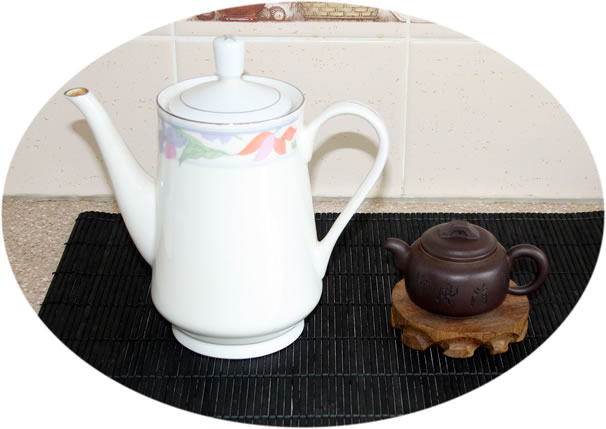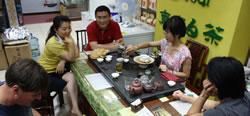It is possible to discern a Yixing Zisha teapot quality at the point of buying
Yixing Zisha teapot
 Many tea consumers are fascinated by Yixing Zisha (宜兴紫砂) teapots. The clay is believed to be the premium clay for brewing the premium teas, especially the fermented teas such as Oolong teas and Pu-erh teas. It is mainly due to the porous nature of the clay which facilitates the brewing process by being able to ‘breath’ through the teapot wall, thus bring out the best of a tea and eliminate certain not so desired elements if presented.
Many tea consumers are fascinated by Yixing Zisha (宜兴紫砂) teapots. The clay is believed to be the premium clay for brewing the premium teas, especially the fermented teas such as Oolong teas and Pu-erh teas. It is mainly due to the porous nature of the clay which facilitates the brewing process by being able to ‘breath’ through the teapot wall, thus bring out the best of a tea and eliminate certain not so desired elements if presented.
The original Yixing Zisha teapot is defined as the items made with the clay produced in the Huang Long Shan (黄龙山) area of the Yixing City. Due to the increasing demand of the product, limited mine deposit and human exploitation, the Chinese official has closed the area from mining since 2005. Any symbolic mining since has been on a very limited scale.
There are however similar mine deposits in the surrounding areas, which are now the main sources of the current Zisha clay supplies. This also opens up a discussion that if these can be called Yixing Zisha and if the quality is comparable.
Zisha products follow the following formula which applies to products of limited resources:
Increasing interest and demand -> increasing prices -> human efforts to increase the production -> substitute products
The Zisha clay itself is in many styles and quality grades. Discerning the quality of a Zisha item at the buying point today is difficult.
Substitute products
Following are some of the methods used to create the ‘substitute products’:
- Using clays mined from elsewhere than Yixing
- Re-composed Zisha using low quality clays mixed with artificial colouring and granule ‘ingredients’
- False claims to appear to naïve Zisha consumers, including clay type, origin, quality and the maker of the Zisha item etc, who have difficulty differentiating.
Following are some of the techniques developed to make the Zisha items look ‘genuine’, which will only add to the confusion:
- Super fine clay, which is lack of the quartz granules, is mostly considered to be of low quality (a topic for a different discussion). Some manufacturers have half fired these clays till they are hard, machine ground them into small particles and mix them with the original clays to achieve the ‘coarse’ appearance. The granules are not the quartz particles as in the genuine Zisha clay. It serves only the appearance but not the functionality of the quartz particles.
- Certain producers mix sand particles and artificial coloring into low grade clay to produce the consistence and texture look like of the high grade Zisha.
As a tea consumer and Zisha lover myself, the one aspect that is of most interest to me above all others (design and details) is the quality of the clay, which is what makes the Yixing Zisha teapots different from others.
Going through a good number of the information available, from both Zisha producers and collectors’ perspectives, it appears there is not a defining set of criteria to guide the Zisha consumer to genuine Yixing Zisha. Experience seems to be the only reliable source. This however can take many years to develop. At the meantime, the ‘substitute products’ are getting better and better at mimicking the genuine products.
Many indicators, buy lack of defining criteria
There are many articles discussing how to differentiate handmade, semi-handmade and industrial machine made Zisha teapots. The implication is, if a Zisha artist is to spend the effort to handmake or semi-handmake a Zisha teapot, the quality of the Zisha clay he/she uses must be at least in reasonable quality to make the effort worthwhile. The quality of the Zisha clay is assumed to go down with the reduction of the level of the ‘hand work’.
This assumption leaves many unanswered questions, even confusions:
- Let alone there are not objective criteria to measure the level of ‘hand work’, there is also not linear correlation between the level of ‘hand work’ and the quality of the Zisha clay.
- What is the difference in the clay quality between the teapots made by different Zisha artists as they use different clays? (The Zisha artists are graded in China based on their experiences and skills. There is however not universal supply of the clays – they simply use what they believe is appropriate among what is available.)
- How about the semi-handmade Zisha vs fully handmade ones? Some of the semi-handmade Zisha items on the current market can easily look as good, even according a pair of experienced eyes, as the fully hand-made ones if not better.
- How about those teapots made by ungraded Zisha artists (民间艺人)? (Like craftsmen of all traditional products, the skills have been passed down by their ancestors. They use the family stock pile of the Zisha clays in their backyards to make the Zisha teapots - in other words the under marketed products.)
The list can keep expending.
The ultimate information and control
The only ones with the ultimate control appear to be the Zisha teapot producers. They decide precisely what goes into making a teapot and how to make them. Without being given the full information, it is rather difficulty for the consumers at the buying end to judgment the quality.
For example, it is relatively easy at the buying point to see the differences between a $40 teapot and $400 teapot, with a bit of the experience of course. It is however not so easy to answer the question if a $2000 teapot is worth of the price tag.
The worst happens when the naïve tourists buy from the shops at the tourist locations. The products are often overly decorated by fancy designs, most come out from machines. It is entirely up to the merchants how much they want to charge as there are not set criteria to label the quality.
Conclusion
Yixing Zisha teapot is fascinating. A good item is absolutely worth collecting. To know if one has a collection value and how to achieve a high money value ratio is however a tricky question for most of the consumers.


